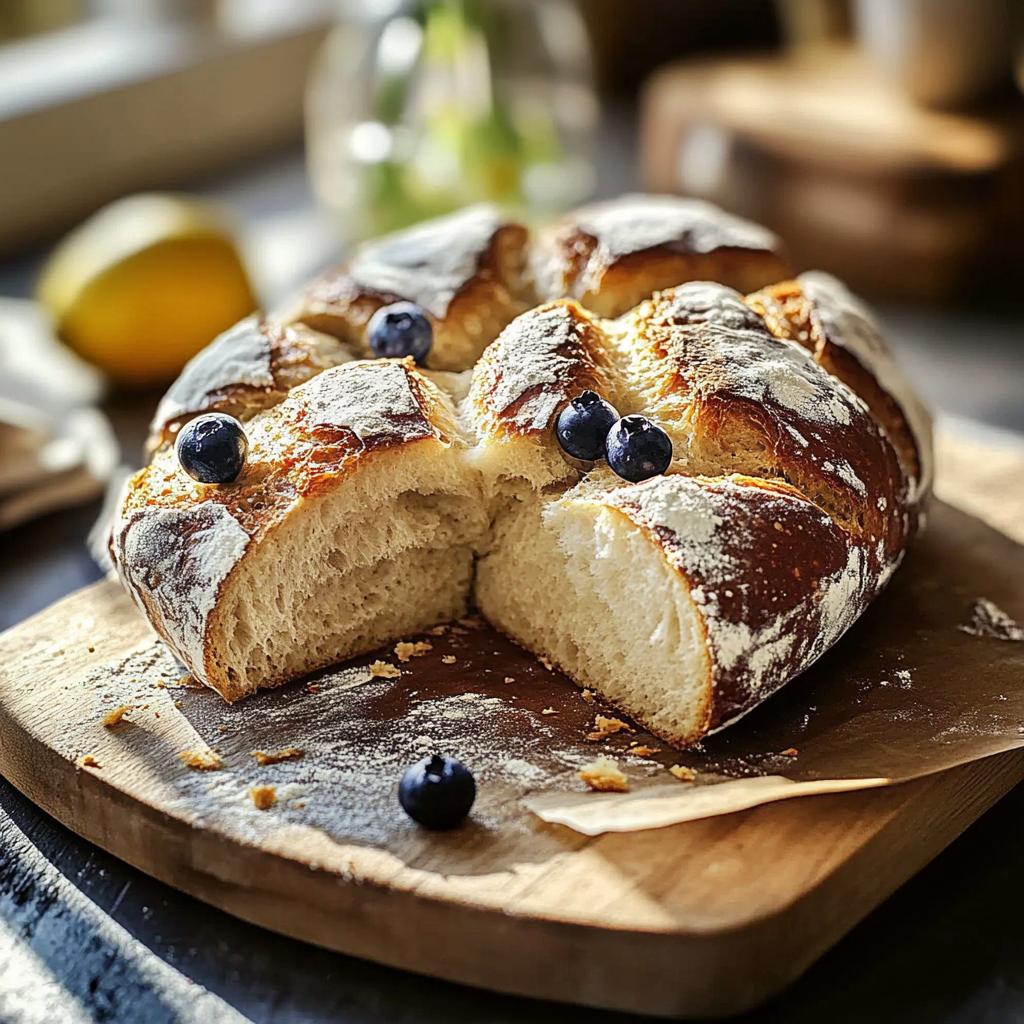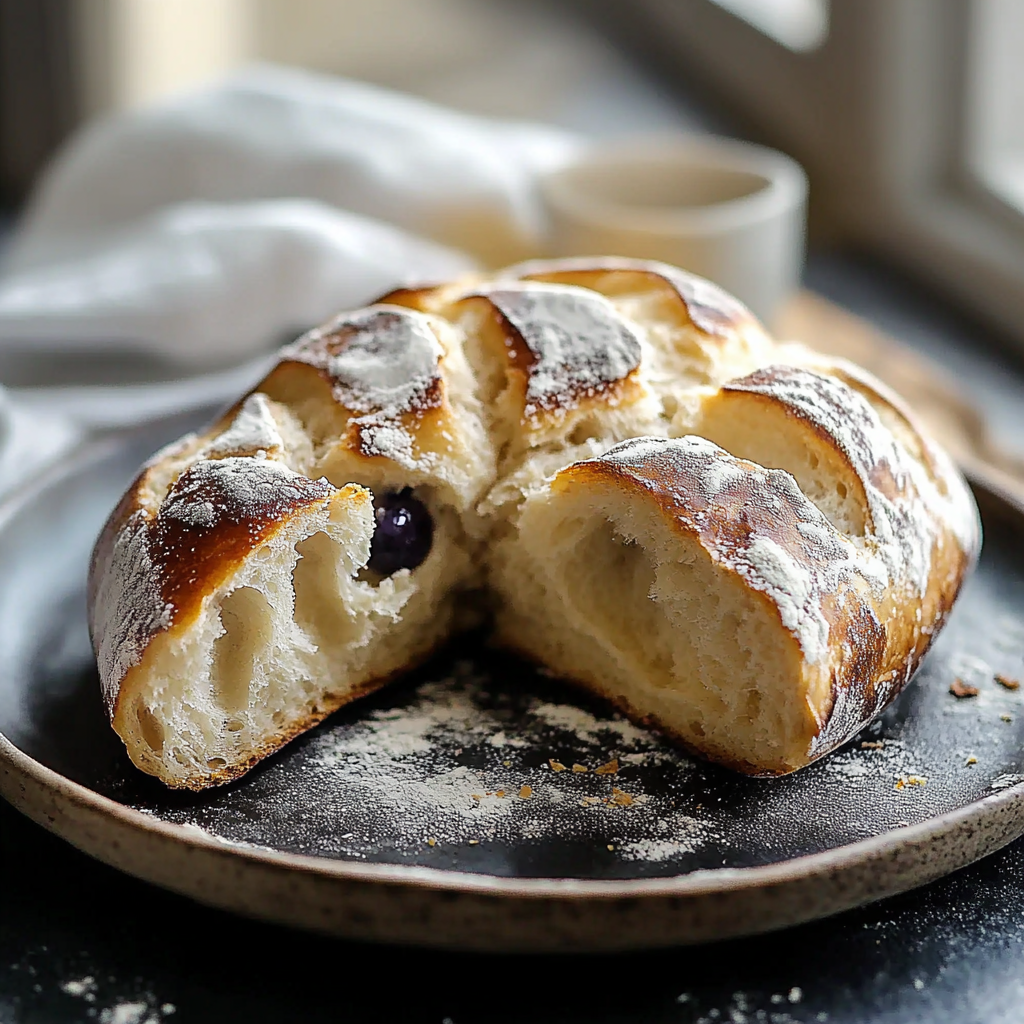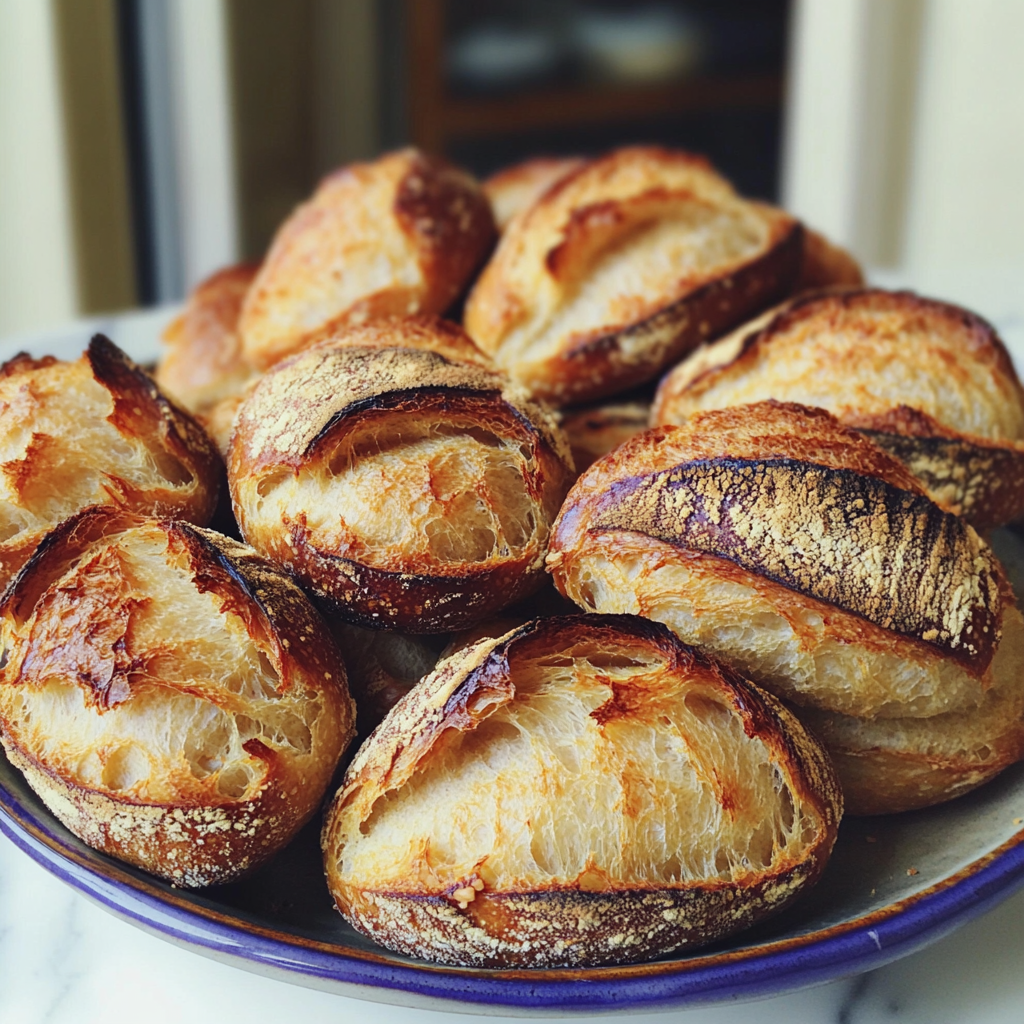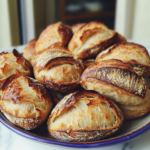Quick Overview
Sweet sourdough bread is a delightful treat that combines the tangy flavor of traditional sourdough with a touch of sweetness. This recipe is perfect for breakfast or as an afternoon snack. With its crispy crust and soft interior, it’s sure to impress your family and friends. Whether you’re new to baking or an experienced chef, this sweet sourdough bread will bring joy to your kitchen. Let’s get started on creating this delicious loaf!
Ingredient Breakdown
Flour
For this recipe, you will need 4 cups of all-purpose flour. This provides the structure and texture necessary for a great loaf. The gluten in the flour gives the bread its chewiness and allows it to rise well.
Water
Use 1 and ½ cups of lukewarm water to activate the yeast and create a moist environment for fermentation. The warmth helps the yeast thrive while contributing to the overall hydration of the dough.
Starter
A healthy sourdough starter is essential; you will need 1 cup. The starter brings that characteristic tangy flavor and helps the dough rise naturally without commercial yeast.
Sugar
Add ¼ cup of granulated sugar for sweetness. This not only enhances the flavor but also helps with browning during baking, creating a lovely crust.
Salt
Make sure to include 1 teaspoon of salt in your mixture; it’s crucial for flavor enhancement and regulating yeast activity, ensuring your bread rises properly without becoming too salty.
Butter
You’ll require 3 tablespoons of melted unsalted butter. This adds richness and moisture to your sweet sourdough bread, resulting in a tender crumb that is hard to resist.
Eggs
Incorporate 2 large eggs into your dough for added richness. Eggs contribute to both flavor and structure, giving your bread an appealing golden color.
Step By Step Recipe: Sweet Sourdough Bread
Prepare the Starter
Begin by ensuring that your sourdough starter is active; feed it at least four hours before starting this recipe. It should be bubbly and have doubled in size. This step ensures that your dough will rise effectively during fermentation.
Mix Dry Ingredients
In a large mixing bowl, combine 4 cups of all-purpose flour with ¼ cup of sugar and 1 teaspoon of salt. Whisk these ingredients together until well blended. Mixing them beforehand prevents clumps from occurring in your dough later on.
Combine Wet Ingredients
In another bowl, mix 1 cup of active sourdough starter with 1 and ½ cups of lukewarm water and 3 tablespoons of melted unsalted butter. Whisk until fully combined. The warmth helps merge all components smoothly for optimal fermentation.
Combine Wet and Dry Mixtures
Gradually pour the wet mixture into the dry ingredients while stirring gently with a wooden spoon until no dry flour remains visible. This process creates a shaggy dough that will come together during kneading.
Knead the Dough
Transfer the dough onto a floured surface and knead for about 8-10 minutes until smooth and elastic. Use your palms to push down on the dough while folding it over itself regularly. Proper kneading develops gluten structure essential for rising.
First Rise
Place the kneaded dough in a lightly greased bowl, cover it with plastic wrap or a damp cloth, and allow it to rise in a warm area for about 2 hours or until doubled in size. Check periodically; this time frame may vary based on ambient temperature.
Shape the Dough
Once risen, punch down the dough gently to release excess gas buildup before transferring it back onto a floured surface. Divide the dough into two equal portions if making two loaves; shape each portion into a round or oval loaf depending on preference.
Second Rise
Place shaped loaves on parchment-lined baking sheets or into greased loaf pans. Cover them loosely with plastic wrap again; allow them to rise for another hour until puffed up again significantly. Patience is key during this stage!
Preheat Oven
During the last few minutes of rising time, preheat your oven to 375°F (190°C). Preheating ensures that when you place your loaves inside, they bake evenly from start to finish without any sudden temperature shifts affecting their rise.
Bake Bread
After rising completes, bake loaves in preheated oven for about 30-35 minutes until golden brown on top while sounding hollow when tapped underneath gently with fingers when done correctly—this means they are ready!
Serving and Storing Tips
Serving Suggestions
Slice sweet sourdough bread thickly or thinly as desired before serving warm from oven or at room temperature alongside butter spread! It pairs wonderfully with jams or honey drizzled over top—a perfect combination for breakfast gatherings!
Storage Guidelines
Store leftover sweet sourdough bread wrapped tightly in plastic wrap at room temperature up to three days maximum freshness maintained! Alternatively freeze slices individually; allow thawing overnight when needed—great way keep enjoying deliciousness longer!
Mistakes to avoid
One common mistake when making Sweet Sourdough Bread is neglecting the importance of proper measurements. Using too much or too little flour can drastically affect the texture and taste. Always weigh your ingredients for accuracy.
Another mistake is skipping the autolyse phase. This step allows the flour to absorb water, enhancing gluten development and improving dough texture. Skipping it may result in a denser loaf.
Additionally, over-proofing the dough can lead to a flat bread. Keep a close eye on your dough during fermentation; it should rise but not double in size completely.
Failing to create sufficient steam in the oven is another pitfall. Steam helps achieve that beautiful crust. Place a pan of water in the oven or mist the dough before baking for best results.
Lastly, ignoring temperature control can ruin your Sweet Sourdough Bread. Ensure your starter is at peak activity and maintain a warm environment for fermentation to thrive.
Tips and tricks
To perfect your Sweet Sourdough Bread, start with a strong starter. A bubbly, active sourdough starter is crucial for achieving great rise and flavor. Feed it regularly and ensure it’s at peak activity before using it in your recipe.
Experiment with different flours to enhance flavor and texture. While bread flour offers a strong gluten structure, adding whole wheat or rye can provide depth to your bread’s taste profile. Consider mixing various flours for a unique flavor combination.
Pay attention to kneading techniques as well. Instead of traditional kneading methods, try stretch-and-fold techniques during bulk fermentation. This gentle method allows gluten development without overworking the dough, leading to a lighter loaf.
Monitoring dough temperature is essential for optimal fermentation. Use an instant-read thermometer to check dough temperature during mixing and bulk fermentation stages. Aim for around 75°F (24°C) for best results; this ensures yeast activity remains high.
Don’t rush through baking; allow your bread to cool fully before slicing. Cutting into warm bread can lead to gummy slices rather than airy crumb structure you desire. Patience pays off!
Suggestions for Sweet Sourdough Bread
Consider adding nuts or dried fruits for added flavor and texture in your Sweet Sourdough Bread. Walnuts, almonds, or raisins complement the natural sweetness beautifully while enhancing nutritional value.
For variations, try infusing spices like cinnamon or nutmeg into your dough. These warm spices pair wonderfully with sweet flavors, creating a cozy aroma as it bakes.
If you prefer a more pronounced sweetness, experiment with honey or maple syrup instead of sugar. These natural sweeteners not only add taste but also contribute moisture to your bread.
You can also try shaping your Sweet Sourdough Bread into different styles such as boules or batards for presentation variety. Different shapes can make serving more exciting and visually appealing at gatherings.
Lastly, consider topping with seeds or oats before baking for added crunch and visual appeal. A sprinkle of sesame seeds or rolled oats creates an inviting crust that enhances both flavor and aesthetics.
FAQs
What makes Sweet Sourdough Bread different from regular sourdough?
Sweet Sourdough Bread incorporates sweeteners like sugar or honey along with an active sourdough starter, resulting in a slightly sweeter flavor profile compared to traditional sourdough that focuses on tanginess from fermentation alone.
How do I know if my sourdough starter is active?
To test if your sourdough starter is active, perform the “float test.” Take a small spoonful of starter and drop it into water; if it floats, it’s ready to use! A bubbly appearance and pleasant aroma indicate peak readiness as well.
Can I use all-purpose flour instead of bread flour?
Yes, you can use all-purpose flour for Sweet Sourdough Bread; however, expect a slightly different texture due to lower protein content compared to bread flour which supports better gluten development.
Why did my bread turn out dense?
A dense loaf could result from under-proofing or using an inactive starter. Ensure adequate fermentation time and check that your starter is bubbly before incorporating it into the dough mix for optimal rise.
How long can I store Sweet Sourdough Bread?
Sweet Sourdough Bread typically stays fresh at room temperature for about 2-3 days when wrapped properly in plastic wrap or stored in an airtight container. For longer storage, consider freezing slices individually.
Can I adjust sweetness levels in my recipe?
Absolutely! You can modify sweetness by adjusting quantities of added sugar or sweeteners according to personal preference while keeping an eye on overall hydration levels in the dough mixture for balance.
Summary
In summary, making Sweet Sourdough Bread involves careful attention to detail regarding ingredient measurements, proofing times, and baking techniques. Avoid common mistakes like over-proofing and neglecting steam creation in the oven while employing helpful tips such as using an active starter and experimenting with various flours. Remember these key points for delicious results every time!
Delicious Sweet Sourdough Bread Recipe
Description
Sweet sourdough bread is a delightful treat that combines the tangy flavor of traditional sourdough with a touch of sweetness. This recipe is perfect for breakfast or as an afternoon snack. With its crispy crust and soft interior, it’s sure to impress your family and friends. Whether you’re new to baking or an experienced chef, this sweet sourdough bread will bring joy to your kitchen. Let’s get started on creating this delicious loaf!
Ingredients
Flour
For this recipe, you will need 4 cups of all-purpose flour. This provides the structure and texture necessary for a great loaf. The gluten in the flour gives the bread its chewiness and allows it to rise well.
Water
Use 1 and ½ cups of lukewarm water to activate the yeast and create a moist environment for fermentation. The warmth helps the yeast thrive while contributing to the overall hydration of the dough.
Starter
A healthy sourdough starter is essential; you will need 1 cup. The starter brings that characteristic tangy flavor and helps the dough rise naturally without commercial yeast.
Sugar
Add ¼ cup of granulated sugar for sweetness. This not only enhances the flavor but also helps with browning during baking, creating a lovely crust.
Salt
Make sure to include 1 teaspoon of salt in your mixture; it’s crucial for flavor enhancement and regulating yeast activity, ensuring your bread rises properly without becoming too salty.
Butter
You’ll require 3 tablespoons of melted unsalted butter. This adds richness and moisture to your sweet sourdough bread, resulting in a tender crumb that is hard to resist.
Eggs
Incorporate 2 large eggs into your dough for added richness. Eggs contribute to both flavor and structure, giving your bread an appealing golden color.




